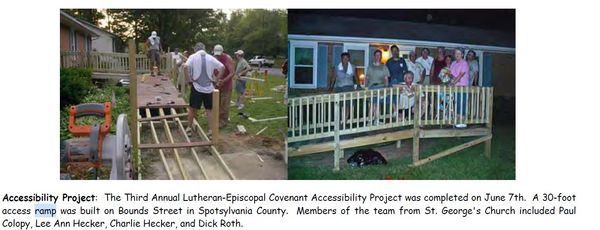St. George’s had had two major encounters with the accessibility issue involving ramps.
Between 2006-2010 Dick Roth from St. George’s and Stan Buch from Christ Lutheran worked together on accessibility projects. Others that joined included LeAnne and Charlie Hecker and Paul Colopy. Generally the total was project was between $1,000 and $1,500 which was split. They were scheduled over a weekend called an accessibility weekend.
This was both an outreach endeavor and a way to encourage the Lutheran Episcopal Covenant of 1997. A joint covenant committee between two local congregations was founded in 1995 on a Vestry motion. This came from a Lutheran Episcopal study group that recommended a committee between St. George’s and Christ Lutheran to “explore ways that our two congregations can grow towards and in full communion with each other.” It would be lay-led with clergy as ex officio looking at worship, education , fellowship, service and ministry.
The newsletter documented 4 of these accessibility weekends, beginning in 2006. It received a boost from the Outreach Commission in 2009 which established a goal of promoting and facilitating more “hands-on” outreach by the congregation. Outreach would help to match talents of parishioners with the projects. Here is a picture from the third in 2008.

The youth picked on it through FredCamp into and blended into the overall renovation of homes in the area in 2010 with “three accessibility ramps, complete siding replacement, demolition and replacement of rotted floors, installation of new windows/doors/security hardware, complete exterior house painting, replacement of old floor coverings and concrete repairs.”
By 2012, the projects had ended, partially due to illness of some of the principles. Outreach was also moving into new ministries, such as the Table and Community Dinner.
Then in the last quarter of 2018, Charlie Russell, a new parishioner, pushed the idea of accessibility ramps again but on a much larger scale with a third party involved. SAWS (“Servants at Work”) builds ramps at homes for people who don’t have the monetary resources to build them. The ramps allow disabled people not to become prisoners in their home The group designs and builds ramps for those whose income is 60 percent or less of the average median income in the county or city of residence. Alternatively the ramps often give the user the freedom to stay in their homes instead of often being forced into early assisted living facilities.
In 2003, Servants At Work was created by Rik Hagarty as a mission of Second Presbyterian Church in Indianapolis, IN. The first ramp was built in that year. The original single church-associated group of ramp builders soon became an independent nonprofit organization whose work is supported by a wide variety of churches, individuals, foundations, organizations and other funders serving 49 counties with 34 affiliates. SAWs is driven solely by donations, grants, sponsorships and volunteers. They have built over 2,000 to date.
Charlie Russell was from Indianapolis and worked with SAWS there but moved to Fredericksburg and desired to export the concept to Virginia.
He wanted to center the efforts at St. George’s with the church providing financial resources to receive donations from other groups and to pay out check to suppliers . The church would be the base of support as he subsequently added support (monetary, labor) from non-profits and churches. This would have bedn very time intensive and would not help to develop his own staff. He shifted the idea to his organization becoming a separate LLC which it did become. The church supports the group through the Outreach commission. In addition, the Easter offering in 2019 was divided between SAWS of Virginia and Haiti. The offering was $2,649 for each group.
The Free-Lance Star on May 24, 2019 provided a front page story on their first ramp in Caroline County. They described the creation a ramp in the home of Glenn and Cassandra Martin in Lake Caroline. There was some dismantling of a existing ramp at that residence but in general the process involves framing up the addition, and adding sturdy railings and a graded ramp.
